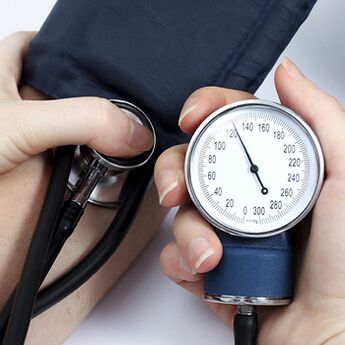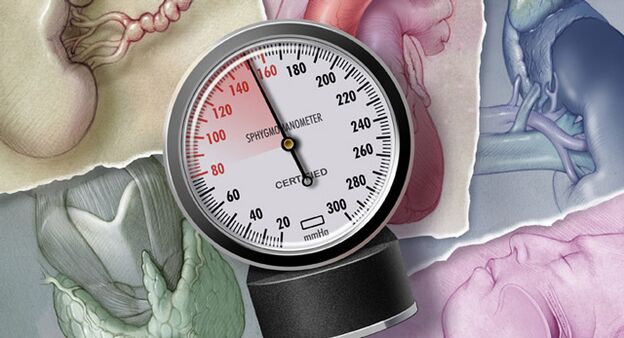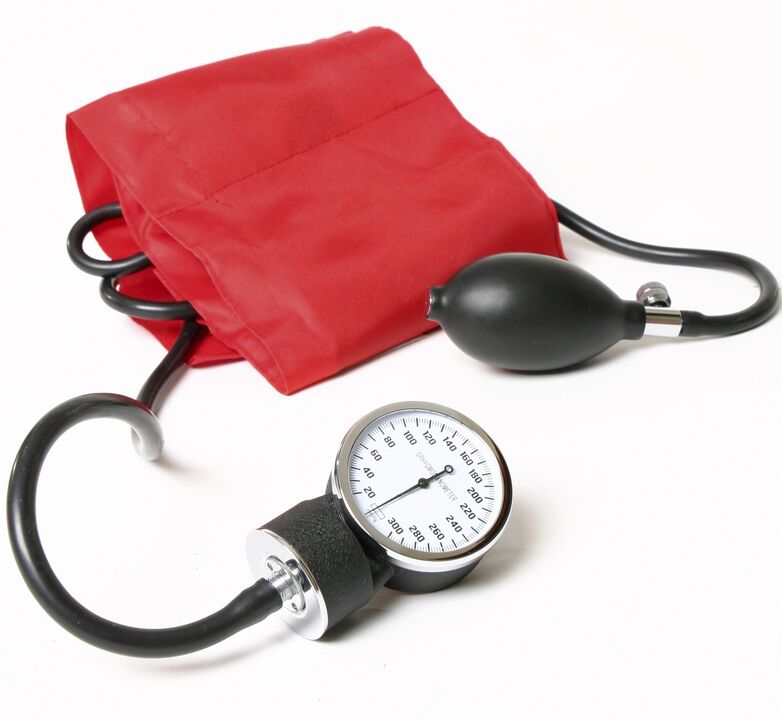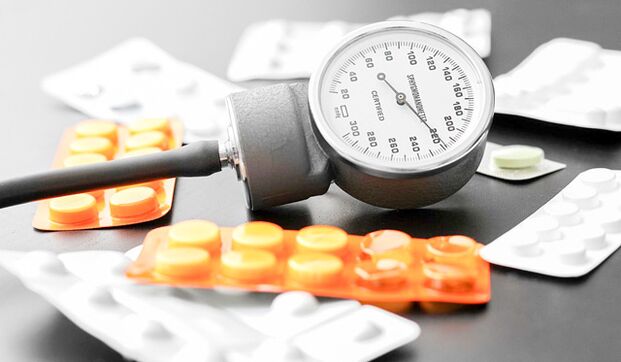
Hypertension (HTN) is one of the most common diseases of the cardiovascular system, which, according to approximate data, affects one-third of the world's inhabitants.Up to 60-65 years of age, more than half of the population was diagnosed with hypertension.The disease is called a "quiet killer" because its signs may be missing for a long time, while changes in blood vessels begin in the asymptomatic stage, which significantly increases the risk of vascular accidents.
In Western literature, the disease is called arterial hypertension (AH).Others have accepted this wording, although both "hypertension" and "hypertension" are still in common use.
The close attention of the problem of arterial hypertension is not so much caused by clinical manifestations as complications in the form of acute vascular disorders of the brain, heart and kidneys.Their prevention is the main purpose of treatment to maintain normal blood pressure (BP).
An important aspect is to identify all possible risk factors,and to clarify their role in the progression of the disease.Diagnosis shows a relationship between hypertension and existing risk factors, which simplifies the evaluation of the patient's condition and prognosis.
For most patients, the numbers in the post -diagnosis of "AH" do not mean anything, although it is clear that the higher the degree and the risk index, the worse the prognosis and the more severe the pathology.In this article, we try to understand how and why one or other degrees of hypertension are diagnosed and what is based on determining the risk of complications.
Causes and risk factors of hypertension
The causes of arterial hypertension are many.SteeringWe are talking about primary or basic hypertension, we andWe think when there is no specific previous disease or pathology of internal organs.In other words, such hypertension itself occurs in itself, involving other organs in the pathological process.Primary hypertension accounts for more than 90% of chronic hypertension.
The main cause of primary hypertension is considered stress and psycho-emotional overload, which contributes to the interruption of the central mechanisms of pressure regulation in the brain, then the humoral mechanisms suffer and the target organs are involved (kidneys, heart, retina).

Secondary hypertension- The manifestation of another pathology, so the cause is always known.It is accompanied by diseases of the kidneys, heart, brain, endocrine disorders and is secondary to them.After the underlying disease has healed, hypertension also disappears, so it makes no sense to determine the risk and degree in this case.Symptomatic hypertension accounts for up to 10% of cases.
The risk factors of hypertension were also known to everyone.Hypertension schools are created at clinics whose professionals convey information on the unfavorable conditions leading to hypertension.Any therapist or cardiologist tells the patient with hypertension first in the first case about the risks.
The most important in circumstances prone to hypertension is:
- Smoking;
- Excess salt in the food, excessive fluid intake;
- Insufficient physical activity;
- Alcohol consumption;
- Overweight and fatty metabolism;
- Chronic psycho-emotional and physical overload.
If you can exclude the factors listed, or at least try to reduce the effects of their health, then characteristics such as gender, age, inheritance cannot be changed, so we have to cope with them, but do not forget the increasing risk.
Classification of arterial hypertension and determination of risk level
Classification of hypertension involves identifying the stage of the disease, the degree of disease and the risk of vascular accidents.
IllnessIt depends on the clinical manifestation.Emphasis:
- Preclinical stage if there are no signs of hypertension and the patient is not aware of the increase in blood pressure;
- Stage 1 of hypertension, when the pressure rises, crises are possible, but there is no sign of the organ damage;
- Stage 2 is accompanied by damage to the target organism - myocardium hypertrophy, the retinal changes in the eyes are noticeable, and the kidneys suffer;
- In Section 3, stroke, myocardial ischemia, vision pathology, changes in large blood vessels (aortic aneurysm, atherosclerosis) are possible.
Level of hypertension
The determination of hypertension is important in assessing risk and prognosis and is based on pressure data.It should be said that normal blood pressure values also have different clinical importance.So the indicator is 120/80 mm Hg.Art.countoptimalTonormalThe pressure will be between 120-129 mmHg.Art.systolic and 80-84 hg hg.Art.diastolic.Pressure numbers 130-139/85-89 mmhg.Art.continue to lie within normal borders but approach the border with pathology, so they are calledvery normal"And the patient can tell the patient high with normal blood pressure. These indicators can be considered pathology because the pressure only means" a few millimeters ".

From the moment the blood pressure reached 140/90 mm Hg.Art.We can already talk about the presence of the disease.This indicator is used to determine the degree of hypertension:
- Degree of hypertension (Stage 1 of HTN or AH diagnosis) represents an increase in pressure in the range of 140-159/90-99 mmhg.Art.
- In Stage 2, headache is 160-179/100-109 hg.Art.
- For high blood pressure at stage 3, the pressure is 180/100 mmhg.Art.and higher.
The data on systolic pressure may increase with a 140 mm Hg amount.Art.and higher while diastolic value is within normal values.They are talking in this caseseparate systolichypertension.In other cases, the systolic and diastolic pressure indicators correspond to different degrees of the disease, and then the doctor will diagnose it to a greater extent, and it does not matter to draw the conclusions based on systolic or diastolic pressure.
The most accurate diagnosis of hypertension is possible when the disease is first diagnosed when treatment has not yet been treated and the patient has not taken antihypertensive drugs.During therapy, numbers decrease and, on the contrary, they can grow suddenly, so that the degree can no longer be properly assessed.
The concept of risk in the diagnosis
It is dangerous due to complications of hypertension.It is no secret that the vast majority of patients are not hypertension itself, but from the acute disorders to which it leads to.
Stroke or ischemic necrosis, myocardial infarction, kidney failure is the most dangerous conditions caused by hypertension.In this respect for all patients after a thorough examinationThe risk is determined, which is shown in the diagnosis by numbers 1, 2, 3, 4.Thus, the diagnosis is based on the degree of hypertension and the risk of vascular complications (for example, hypertension/high blood pressure stage 2, risk 4).
Risk stratification criteriaThe presence of patients with hypertension, external conditions, other diseases and metabolism disorders, the involvement of target organs and the simultaneous changes in organs and systems are used.
The main risk factors affecting the prognosis are as follows:
- The patient's age after 55 years for men and 65 in women;
- Smoking;
- Lipid metabolism disorders (exceeding cholesterol norms, low-density lipoproteins, decreased high density lipid fractions);
- The presence of cardiovascular pathology in the family among blood relatives under 65, for women and men;
- Body weight is superfluous when the abdominal district exceeds 102 cm and women 88 cm.
The factors listed are considered to be the most important, but many patients with hypertension suffer from diabetes, impaired glucose tolerance, lives in a sedentary life, and abnormalities in the blood coagulation system in the form of increased fibrinogen concentration.These factors take into accountfurther, increases the likelihood of complications.
Damage to the target organism from stage 2 characterizes hypertension and serves as an important criterion that determines the risk, so the patient's examination includes ECG, heart ultrasound of muscular hypertrophy, blood and urine testing of kidney function.
Above all, the heart suffers from high blood pressure, which pushes the blood into the blood vessels with increased force.As the arteries and arterioles change when the walls lose elasticity and the lumen becomes cramping, the heart load gradually increases.A characteristic property taken into account when taking into account the layer of riskmyocardial hypertrophywhich can be suspected by the ECG by ultrasound examination.
The participation of the kidneys as a target system is the growth of creatinine in the blood and urine, as well as the appearance of albumin protein in the urine.In the background of hypertension, the walls of large arteries are thickened, atherosclerotic plaques that can be detected with ultrasound (carotis, brachiocephalic arteries).
The third stage of hypertension is associated with related pathology, ie hypertension.Among the related diseases, prognosis is most important for stroke, temporary ischemic attacks, heart attack and angina, diabetes nephropathy, kidney failure, retinopathy (retinal damage) due to hypertension.
So the reader is likely to understand how to determine the degree of headache independently.This is not difficult, you just need to measure the pressure.You can then think about the presence of certain risk factors, take into account age, gender, laboratory parameters, ECG data, ultrasound, etc.
For example, the patient's blood pressure corresponds to stage 1 hypertension, but at the same time suffered a stroke, which means that the risk is maximum - 4, even if stroke is the only problem with high blood pressure.If the pressure corresponds to the first or second degree, and the only risk factor that can be noted, smoking and age in the background of quite good health, then the risk is moderate - GB 1 tablespoon.(2 tablespoons), risk 2.
To make it clearer, you can summarize everything in a small table.By defining the degree and "counting" the factors listed above, you can determine the risk of complications of vascular accidents and hypertension in a particular patient.Number 1 is a low risk, 2 - medium, 3 - high, 4 - Very high risk.
| Risk factors | BP 130-139/85-89, risk | GB (AH) 1, Risk | GB 2, risk | GB 3, risk |
|---|---|---|---|---|
| none | 1 | 2 | 3 | |
| 1-2 | 1 | 2 | 2 | 4 |
| More than three factors/target injury/diabetes | 3 | 3 | 3 | 4 |
| related pathology | 4 | 4 | 4 | 4 |
Low risk means that the likelihood of vascular accidents does not exceed 15%, moderate up to 20%, high risk indicates that complications develop in one-third of patients from this group, more than 30%of patients are prone to complications.
Manifestation and complications of headache
The manifestations of hypertension are determined by the stage of the disease.During the preclinical period, the patient feels good and only reading the tonometer indicates the developing disease.

When changes in blood vessels and heart progress, symptoms occur in the form of headaches, weakness, decreased power, periodic dizziness, visual symptoms, in the form of weakened visual acuity, in the form of blotting "spots" in front of the eyes.All these signs are not expressed during the stable course of pathology, but when the hypertonic crisis is developed, the clinic becomes lighter:
- Severe headache;
- Noise, ringing of the head or ear;
- Darkness in his eyes;
- Pain in the heart area;
- Dyspnea;
- Face hyperemia;
- Finding and fear of fear.
Hypertonic crises are provoked by traumatic situations, overtime, stress, coffee consumption and alcoholic beverages, so patients with already developed diagnosis should avoid such effects.In the background of the hypertonic crisis, the likelihood of complications is suddenly increased, including life -threatening:
- Bleeding or cerebral infarction;
- Acute hypertonic encephalopathy, possibly cerebral edema;
- Pulmonary edema;
- Acute kidney failure;
- Heart attack.
How to measure blood pressure correctly?
If there is a reason for suspected hypertension, the first thing a specialist does is to measure it.Until recently, it has been believed that the number of blood pressure could generally differ in different hands, but as the exercise has shown, even 10 mm Hg difference.Art.The pathology of the peripheral blood vessels may occur, so the different pressure of the right and left hands should be treated with caution.

To produce the most reliable figures, it is recommended to measure the pressure three times on each arm with short periods of time, fix the results obtained.In most patients, the lowest values they receive are the most appropriate, but in some cases the pressure increases from measurement to measurement, which does not always speak with hypertension.
A large selection and availability of devices for measuring blood pressure allows it to observe it on a wide range of home people.Usually hypertension patients are at home with a tonometer in their hands, so if their health deteriorates, they can immediately measure blood pressure.It is worth noting, however, that fluctuations are possible in absolute healthy individuals without hypertension, so a single surplus of norms should not be considered as a disease and the pressure should be measured at different times and repeatedly to diagnose hypertension.
When diagnosing hypertension, blood pressure, electrocardiographic data and heart auszculation results are essential.The noise, increased sounds and arrhythmia are possible when listening.The ECG shows signs of stress on the left side of the heart.
Treatment of hypertension
In order to improve hypertension, treatment orders have been developed that contain various groups and various mechanisms of action.TheirsThe combination and dose are selected separately by the doctorConsidering the stage, simultaneous pathology and hypertension response to a particular drug.After the diagnosis of hypertension and before the treatment of medication, the doctor recommends non -medicated measures that significantly increase the efficiency of pharmacological drugs and sometimes allow the dose of drugs or at least a few.
Above all, normalization of the system, eliminating stress and ensuring physical activity.The purpose of the diet is to reduce salt and fluid intake, to eliminate alcohol, coffee and beverages, as well as stimulating substances in the nervous system.If you are overweight, you should limit your calories and avoid fatty, flour, fried and spicy foods.
Non -drug measures in the early stages of hypertension can have such a good effect that the need for prescription drugs is no longer required.If these measures do not work, your doctor will prescribe appropriate medications.
The purpose of treating hypertension is not only to reduce blood pressure, but also the reason for it.

Anti -antihypertensive drugs from the following groups are traditionally used to treat hypertension:
- Diuretics;
- Angiotensin II receptor antagonists;
- Ace inhibitors;
- Adrenergic blockers;
- Calcium channel blockers.
Every year, the list of blood pressure reduction drugs increases and at the same time becomes more effective and safer, with less harmful reactions.A drug is prescribed at a minimal dose at the start of treatment;If not effective, it can be increased.If the disease progresses and the pressure does not remain acceptable, another group will be added to the first drug from another group.Clinical observations show that the effect is better with combined therapy than prescribing a maximum amount of drugs.
Reducing the risk of vascular complications is important in choosing the treatment system.Thus, it has been noted that some combinations have a more prominent "protective" effect on the organs, while others allow better pressure to check.In such cases, experts prefer a combination of drugs, which reduces the likelihood of complications, even if there is a daily fluctuation of blood pressure.
In some cases, the concomitant pathology should be taken into account that adjusts headache management systems.For example, men with prostate adenoma prescribe alpha blockers that are not recommended for constant use to reduce blood pressure in other patients.
The most widely used ACE inhibitors, calcium channel -blocking,which are prescribed for both young and elderly patients, with simultaneous diseases, diuretics, and shitches.In these groups, medicines are suitable for initial treatment, which can then be complemented by another composition of third drug.
ACE inhibitors lower blood pressure and at the same time exert a protective effect on the kidneys and myocardium.They are beneficial in young patients, women taking hormonal contraceptives, diabetes and older patients.
DiureticsNo less popular.They are combined with SAO inhibitors to reduce side effects, sometimes in a tablet.
Beta -blockersIt is not a priority group of hypertension, but are effective in the pathology of the simultaneous heart - heart failure, tachicardia, coronary heart disease.
Calcium channel -blockersCombined with ACE inhibitors, it is often prescribed, especially good for bronchial asthma, combined with hypertension because they do not cause bronchial.
Angiotensin receptor antagonists- The most successful group of hypertension.They effectively lower blood pressure and do not cause coughing like many ACE inhibitors.But they are particularly common in America due to 40% reduction of Alzheimer.
When treating hypertension is not only a choice of an effective treatment system, but also the medication for a long time, even for life.Many patients believe that when the pressure reaches normal levels, treatment can be stopped, but the tablets are grasped during the crisis.It is known that the systematic use of antihypertensive drugs is even more harmful to health than a complete lack of treatment, so informing the patient about the duration of treatment is one of the important tasks of the doctor.























